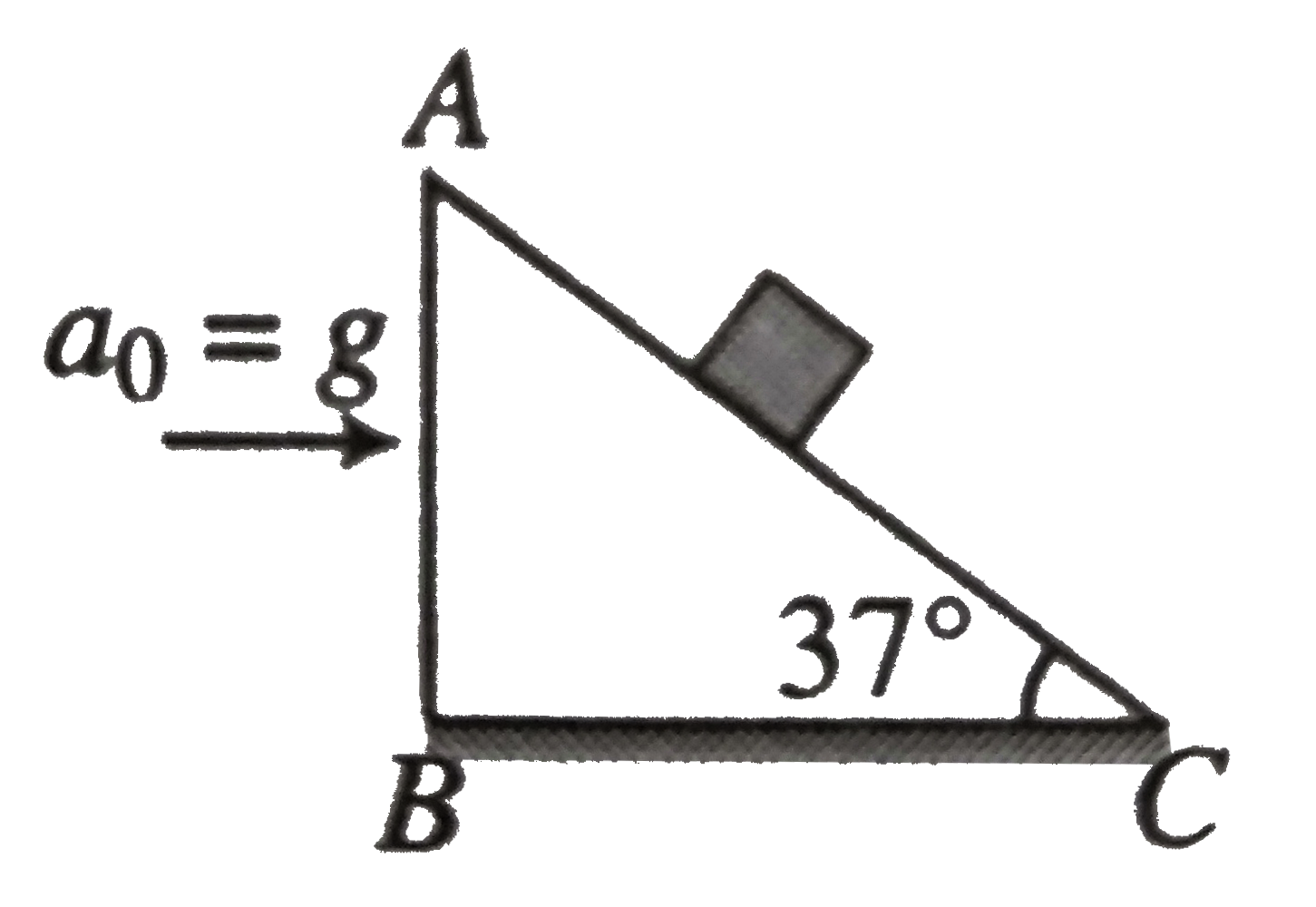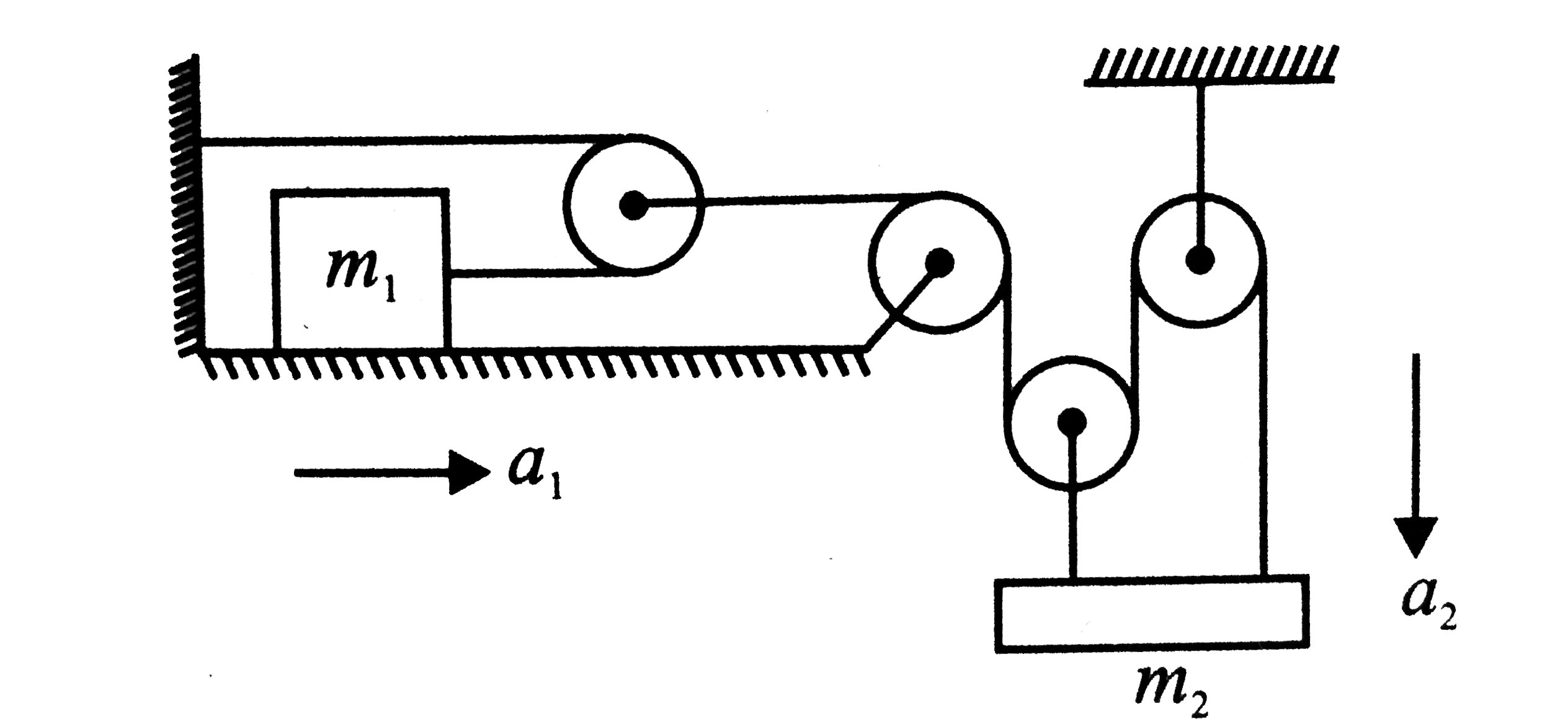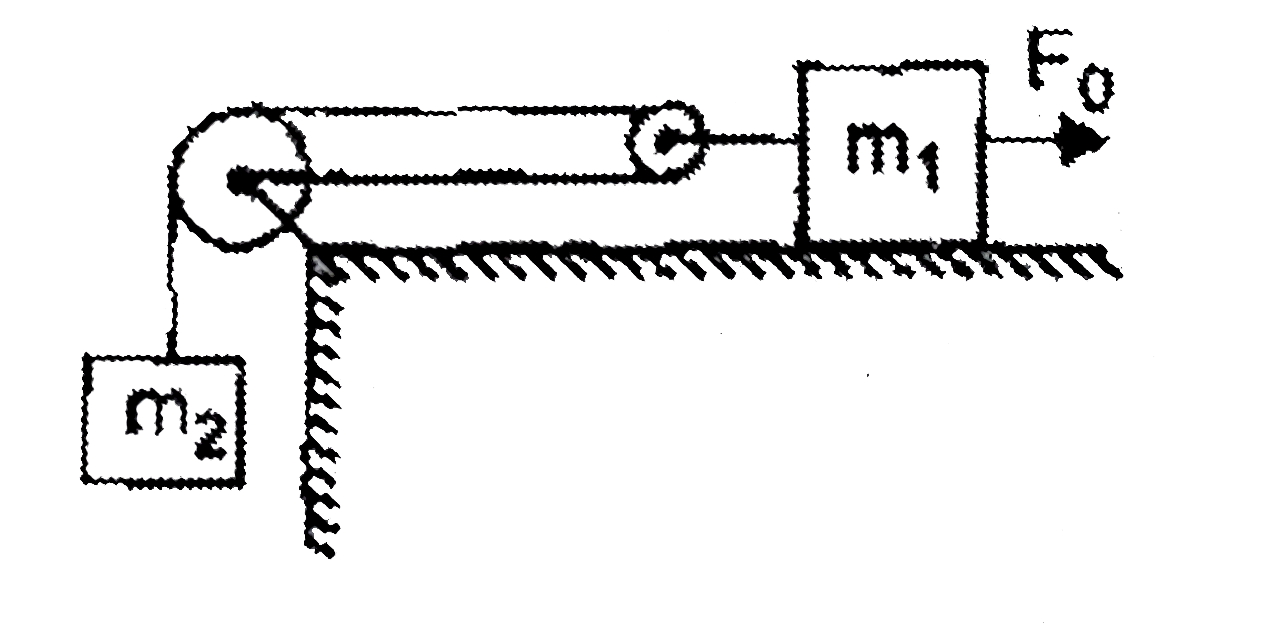Two blocks of masses m1 and m2 are connected with a light spring of force constant k and the whole system is kept on a frictionless horizontal surface. The masses are applied forces F1 and F2 as shown in fig. At any time the blocks have same acceleration a0 but in opposite direction. Now answer the following :

The value of a0 is
F1m1−m2gm1=F2m2−m1gm2
F1m2=F2m1
F1m1+m2gm1=F2m2+m1gm2
F1m1=F2m2
The correct Answer is:D
In horizontal direction, both m1 and m2 will have same acceleration for any case. In vertical direction also, they should have same acceleration. Let it be a upwards for boths, then
F1−m1g=m1a..(i)
F2−m2g=m2a …(ii)
From (i) and (ii) , F1m1=F2m2.
Topper's Solved these Questions
- NEWTON'S LAWS OF MOTION 1BOOK - CENGAGE PHYSICS ENGLISHCHAPTER - NEWTON'S LAWS OF MOTION 1EXERCISE - Integer
5 Videos
- NEWTON'S LAWS OF MOTION 1BOOK - CENGAGE PHYSICS ENGLISHCHAPTER - NEWTON'S LAWS OF MOTION 1EXERCISE - Assertion-reasoning
15 Videos
- MISCELLANEOUS VOLUME 2BOOK - CENGAGE PHYSICS ENGLISHCHAPTER - MISCELLANEOUS VOLUME 2EXERCISE - INTEGER_TYPE
10 Videos
- NEWTON'S LAWS OF MOTION 2BOOK - CENGAGE PHYSICS ENGLISHCHAPTER - NEWTON'S LAWS OF MOTION 2EXERCISE - Integer type
1 Video
Similar Questions
A block is placed on an inclined plane moving towards right horizontally with an acceleration a0=g. The length of the plane AC=1m. Friction is absent everywhere. Find the time taken (in seconds) by the block to reach from C to A.

View SolutionStatement I: The driver of a moving car sees a wall in front of him. To avoid collision, he should apply brakes rather than taking a turn away from the wall.
Statement II: Frictional force is needed to stop the car or taking a turn on a horizontal road.
View SolutionTwo blocks are arranged as shown in figure. Find the ratio of a1/a2. (a1 is acceleration of m1 and a2 that of m2)

View SolutionA block is moving on an inclined plane making an angle 45∘ with the horizontal and the coefficient of friction is μ. The force required to just push it up the inclined plane is 3 times the force required to just prevent it from sliding down. If we define N=10μ, then N is
View SolutionTwo blocks of masses m_(1) and m_(2) are connected with a light spring of force constant k and the whole system is kept on a frictionless horizontal surface. The masses are applied forces F_(1) and F_(2) as shown in fig. At any time the blocks have same acceleration a_(0) but in opposite direction. Now answer the following : The value of a_(0) is
View SolutionTwo blocks of masses m1 and m2 are connected with a light spring of force constant k and the whole system is kept on a frictionless horizontal surface. The masses are applied forces F1 and F2 as shown in fig. At any time the blocks have same acceleration a0 but in opposite direction. Now answer the following :

the value of spring force is
View SolutionTwo blocks of masses m1 and m2 are connected with a light spring of force constant k and the whole system is kept on a frictionless horizontal surface. The masses are applied forces F1 and F2 as shown in fig. At any time the blocks have same acceleration a0 but in opposite direction. Now answer the following :

If F2 is removed at this moment, then just after the acceleration of m2 is
View SolutionTwo blocks of masses m_(1) and m_(2) are connected by an ideal sprit, of force constant k . The blocks are placed on smooth horizontal surface. A horizontal force F acts on the block m_(1) . Initially spring is relaxed, both the blocks are at rest. What is acceleration of centre of mass of system at the instant of maximum elongation of spring
View SolutionA block of mass m_(1) on asmooth, horizontal surface is connected to a second mass m_(2) by a light string over a height, frictionless pulley. A force of magnitude F_(0) is applied to mass m_(1) . Find the value of force F_(0) for which the system will be is equilibrium.
View SolutionA block of mass m1 on a smooth, horizontal· swface is: connected to a second mass m2 by a light cord ovbr a light,: frictionless pulley as shown. (Neglect the mass of the cord and' of the pulley). A force of magnitude F0 is applied to mass m1· as shown. Neglect any friction.

(a) Find the value of force F0 for which the sy!tem will be in equilibrium.
(b) Find the acceleration of masses andtensio~ in string if F0 has a value which is double of that foun,d in part (a).
View SolutionTwo blocks of mass m_(1) and m_(2) are connected by a spring of force constant k. Block of mass m_(1) os pulled by a constant force f_(2) [see fig 4E.19 (a)] find the maximum elongation in the spring .
View SolutionTwo blocks of masses m1andm2 being connected with a light spring of stiffness k are driven with forces F1andF2 on a smooth horizontal plane.

View SolutionTwo blocks of masses m1 and m2 are connected by a spring having spring constant K. Initially , the spring is at its natural length. The coefficient of friction between the blocks and the surface is μ. What minimum constant force has to be applied in the horizontal direction to the block of mass m1, in order to shift the other block ?
View SolutionTwo blocks m1andm2 are connected by a massless spring of force constant k F1andF2 are two forces acting on m and m1andm2 as shown. The arrangement is on a horizontal plane.

View Solutionघर्षण रहित क्षैतिज पृष्ठ पर द्रव्यमान m1 तथा m2 के तो ब्लॉक जो कमानी नियतांक k की हल्की कमानी से युग्मित है, पर बल F1 तथा F2 कार्यरत है। यदि दोनों ब्लाकों का त्वरण किसी क्षण समान है , तो तत्क्षणिक कमानी बल ज्ञात कीजिए।

View SolutionTwo block of masses m_(1) and m_(2) connected by a light spring rest on a horizontal plane. The coefficient of friction between the block and the surface is equal to mu . What minimum constant force has to be applied in the horizontal direction to the block of mass m_(1) in order to shift the other block?
View Solution

